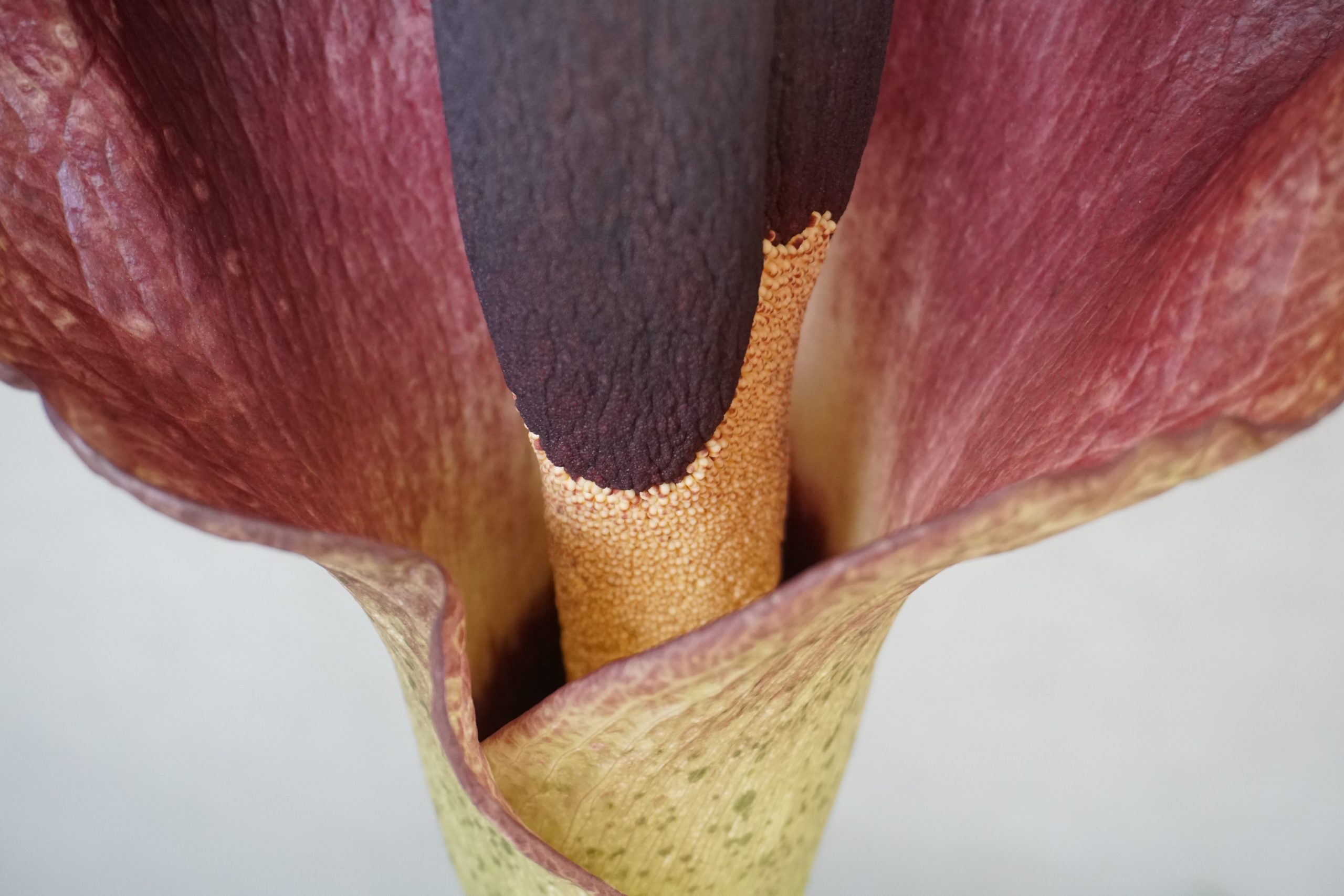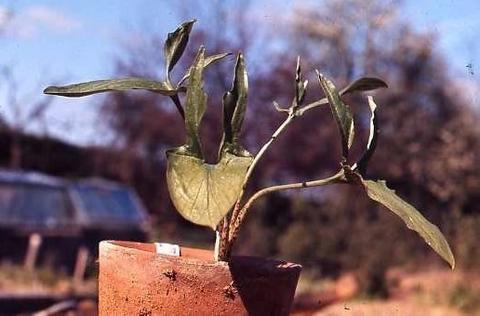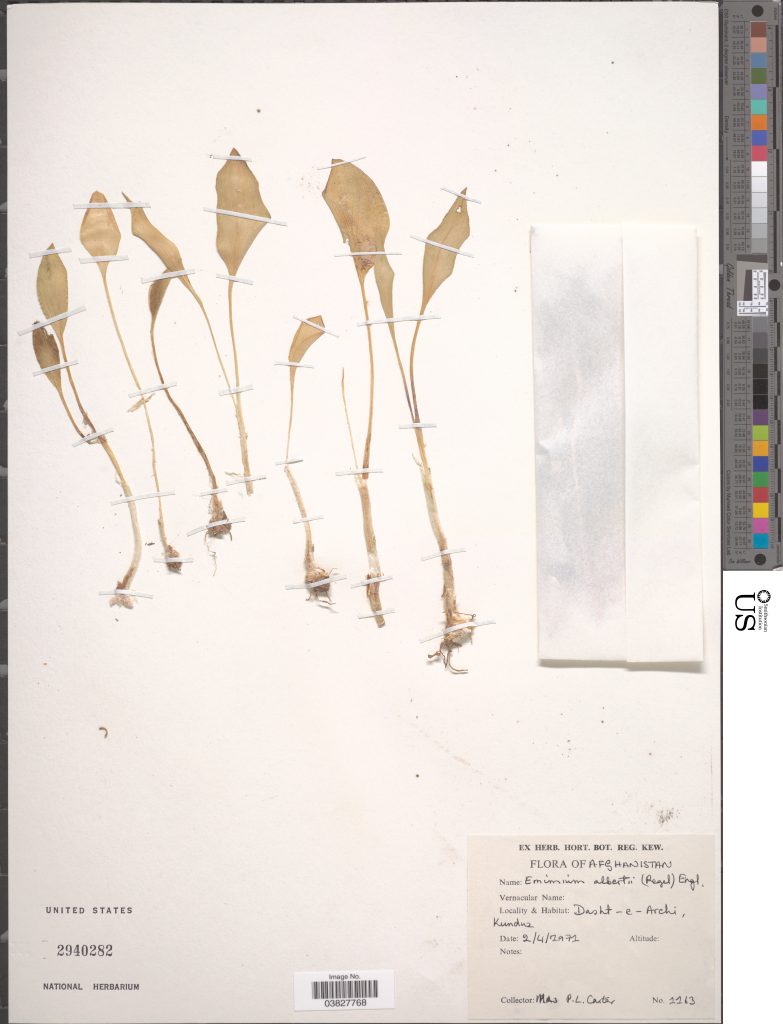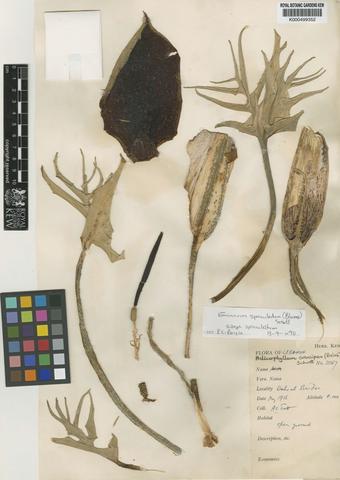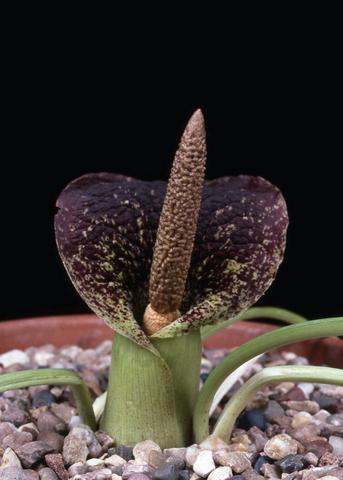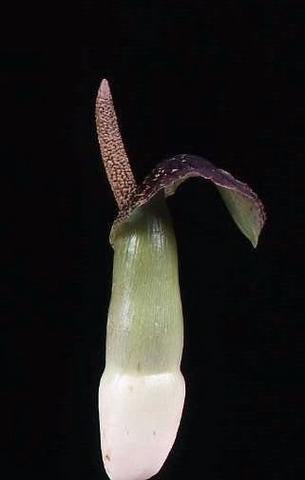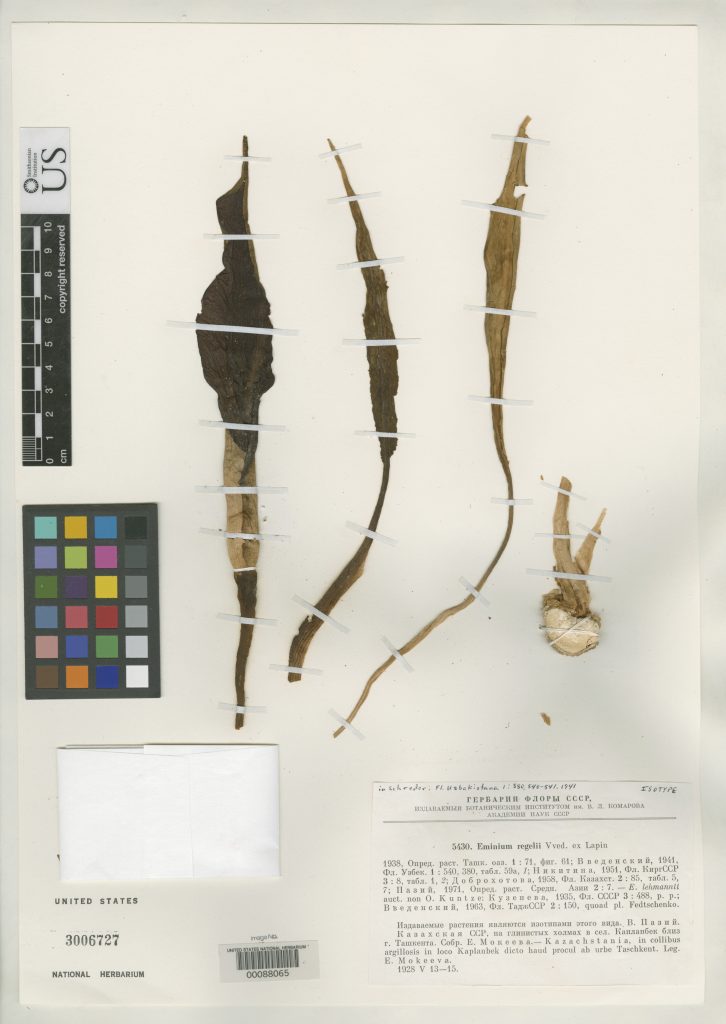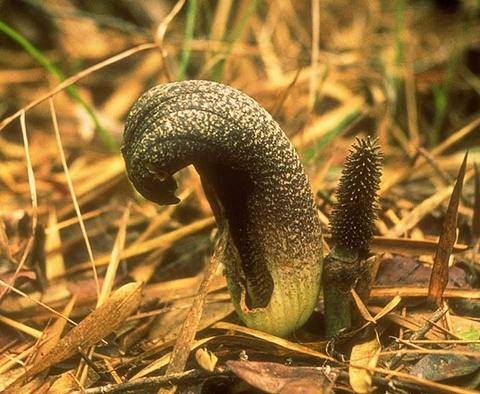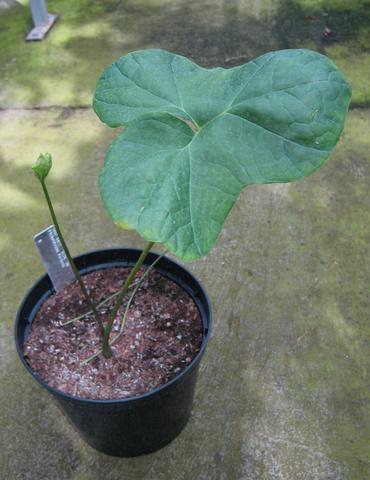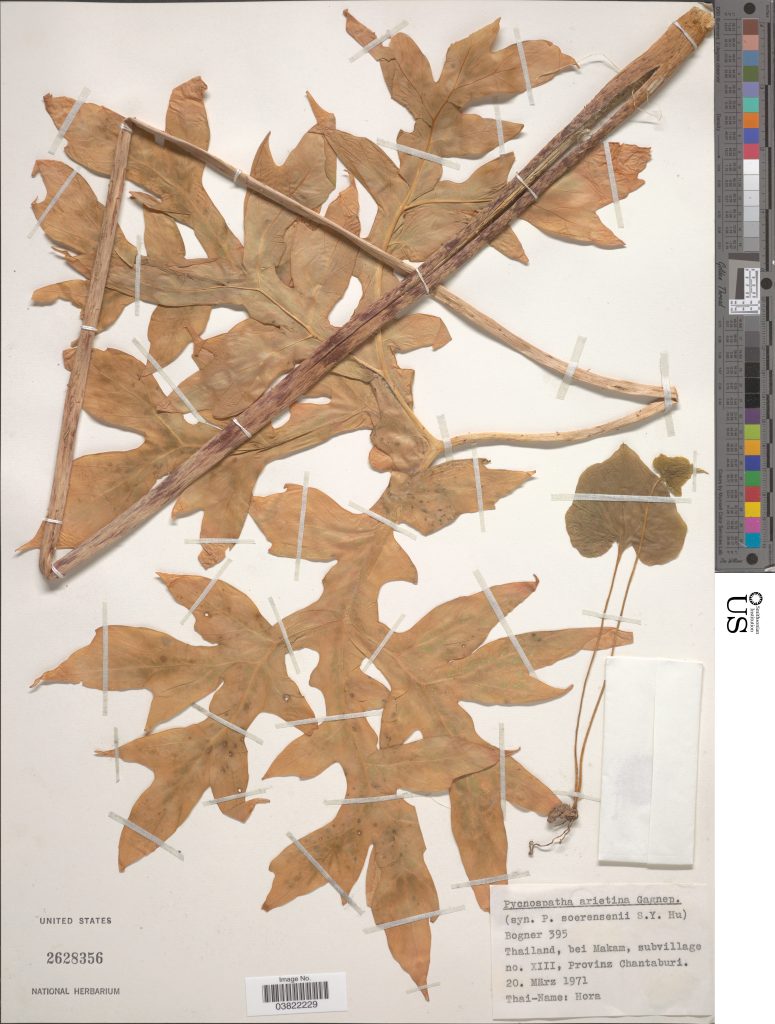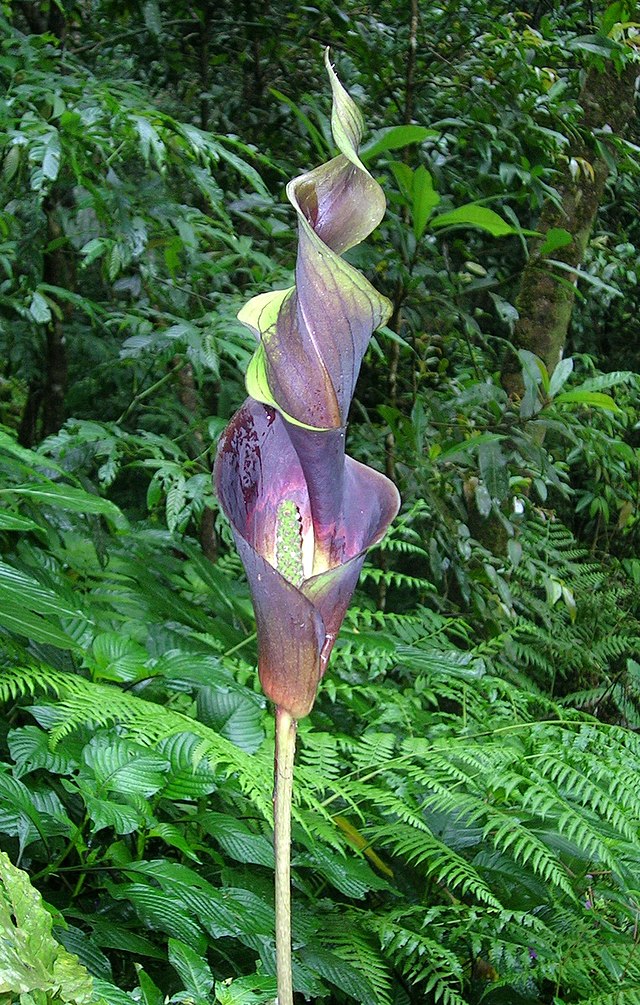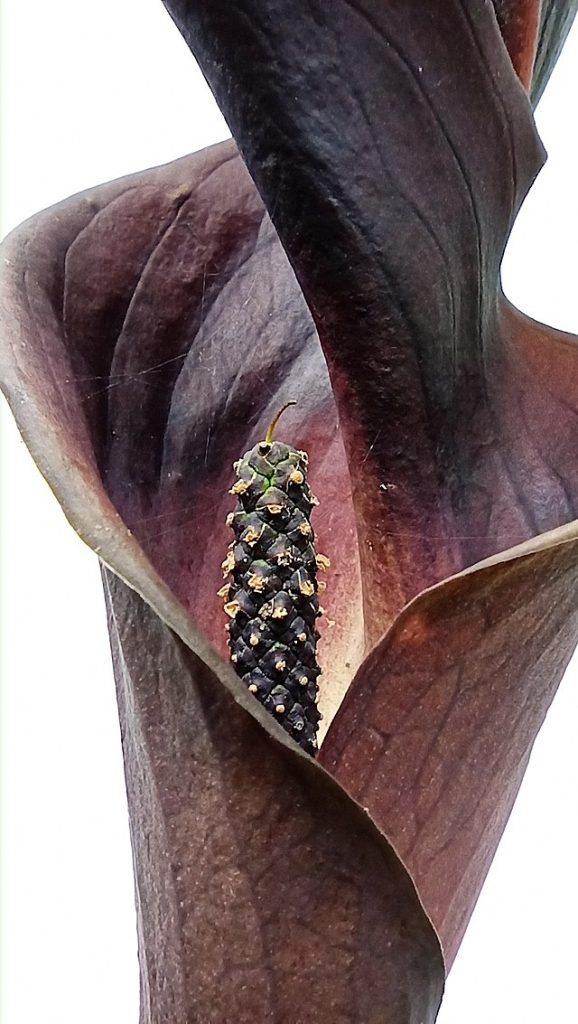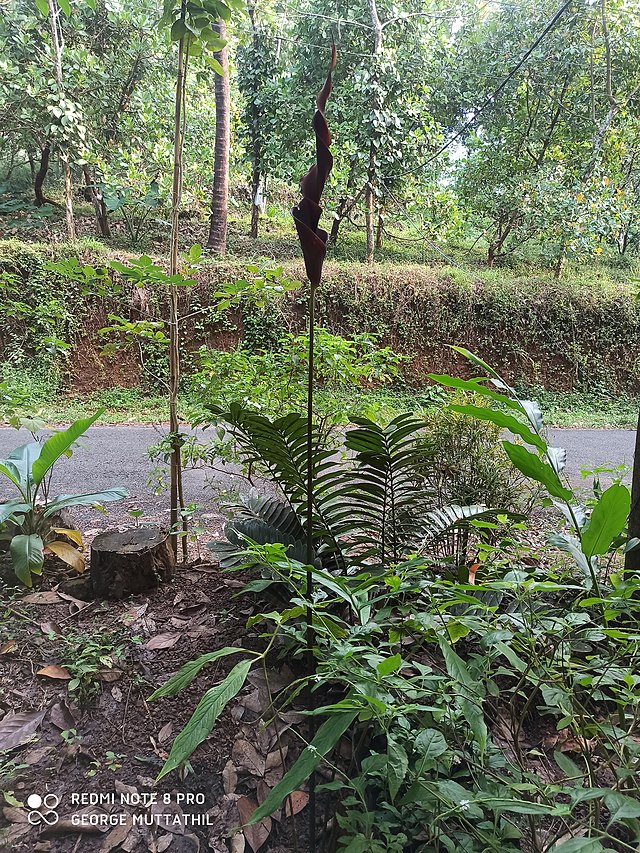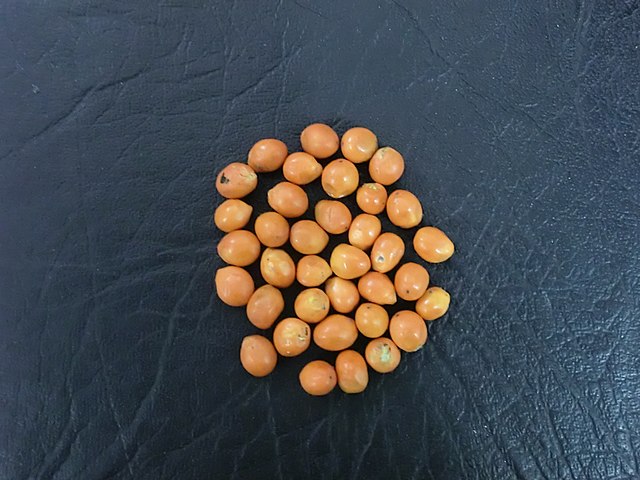THE GENERA OF ARACEAE
Background:Part of a poster that sold with the 1991 Missouri Botanical Garden calendar.
Eminium
Eminium is a genus belongs to Araceae. The genus Eminium is different from the most of Araceae species, they inhabit sandy places in Middle East, Central Asia. It contains 9 species1. Cultivation of this genus is very difficult even for researchers2.
Description
Leaf: 3 to 6 leaves3. All have tuberous stems and survive part of the year in a leaf-less condition4. Adequate sunlight is essential during cultivation. Without sufficient sunlight, the plant utilizes the nutrients in the tuber to enlarge its leaves, depleting the tuber of nutrients in the process.5 In their paper, Lobin and Boyce discussed differences in leaf morphology and suggested the existence of two classification groups: one with leaves that do not branch and another with leaves that branch. For more details, please refer to their paper and explore the specifics of leaf variations.6
Inflorescence: The floral morphology is characterized by features such as bullet-shaped appendix, hair-like projections between male and female flowers, and dark-colored spathe. However, due to the diversity, not all species exhibit these characteristics.
Tuber: Subglobose7.
Fruits: Subglobose. It often contains 1 seed8.
Distribution9
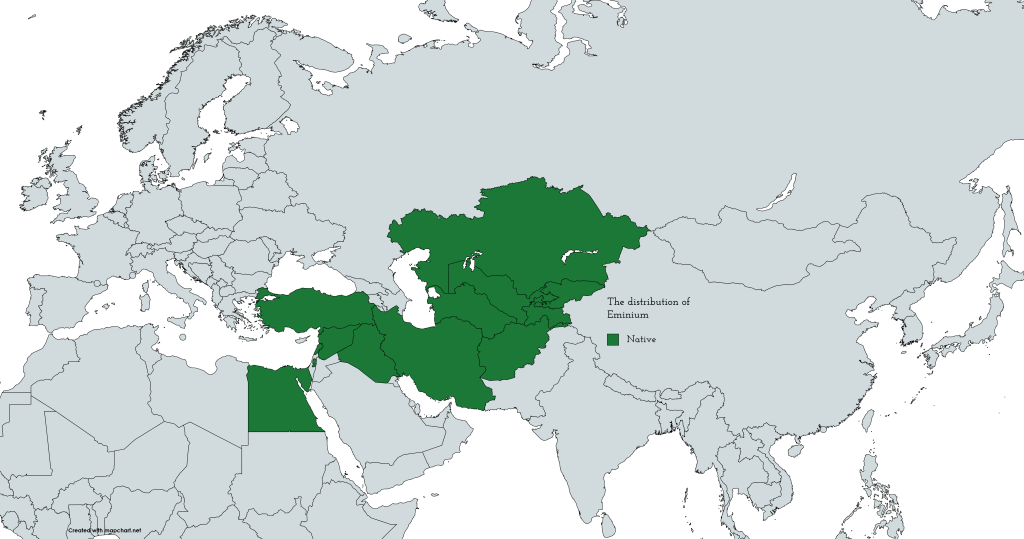
Native to: Afghanistan, Egypt, Iran, Iraq, Kazakhstan, Kirgizstan, Lebanon-Syria, Palestine, Sinai, Tadzhikistan, Turkey, Turkmenistan, Uzbekistan
Ecology10
Warm temperate and subtropical habitats in fields, savannas, semideserts, deserts; geophytes, stony or sandy ground, consolidated sand.
Etymology11
Ancient name eminion, mentioned by Dodoens (1574).
Pycnospatha
The genus Pycnospatha belongs to Araceae. This genus has very unique appearance and that is very similar to the genus Dracontium. It contains 2 species12 from mainland southeast asia.
Description
❶13 Pyenospatha Thorel ex Gagnepain, Bull. Soc. Bot. France 88: 512. 1941. TYPE: P. palmata Thorel ex Gagnepain [Type: Laos: Ben-chom, Sedom, Thorel 2404 (holotype, P).] Cormous herbs with solitary highly dissected leaves on spiny spongy petioles, emerging from the cataphylls early as in Dracontium species; posterior lobes forked 3 times, anterior lobe trifid, the central member trifid again, the laterals unequally forked; leaflets sessile, ± confluent, with brochidodromous pinnate venation, or the leaf entire with the anterior lobe trisect with a pair of opposite lateral lobes, and the posterior lobes 1 x pedatifid; rachides with scattered leaflets throughout. Inflorescence solitary, accompanying the leaf, peduncle much shorter than the petiole; spathe sharply hood-forming, purple with pale longitudinal streaks; spadix sessile or shortly stipitate. Flowers hermaphrodite throughout, atepalate; stamens 6+; ovary unilocular, uniovulate with basal to subbasal placentation, style elongated, stigma punctiform. Fruit a reddish spiny berry ca. 1 cm diam. (Fig.7), pericarp (in spirit material) hard, rather corky, firmly appressed around the seed. Seed black or very dark brown, seed coat hard, thick, warty, containing white druses in "tegmic" layer of pachychalaza (Figs. 5d, 6d). ❷14 Small to large, slender to robust, seasonally dormant herbs. Stem a subglobose tuber. Leaves 1-2 together; petiole smooth, rough or aculeate, mottled, sheath very short; leaf blade tri-partite to 'dracontioid', anterior division simple to trifid, segments simple to pinnatifid posterior divisions simple to bifid to pedatifid, segments then simple to pinnatifid, ultimate lobes decurrent, ovate-elliptic to triangular, acute to acuminate; primary lateral veins pinnate, running into distinct marginal vein; higher order venation reticulate. Inflorescence solitary, appearing before or with leaf; peduncle much shorter than petiole, although predominantly epigeal, similar in appearance and texture to petiole; spathe margins not overlapping, upper spathe strongly hooded, thick, marcescent; spadix much shorter than spathe, conical to ovoid-conoid, stipitate, fertile to apex; flowers bisexual, perigone absent; stamens ca 6 or more per flower, free, crowded densely together with those of neighbouring flowers; filaments oblong, flattened, connective slender; thecae oblong-ellipsoid, dehiscing by apical, pore-like slits; gynoecium elongate-flask-shaped, ovary 1-locular, ovule 1, anatropous to hemianatropous, funicle short, placenta basal to subparietal, stylar region greatly elongated, straight or somewhat curved, projecting well beyond stamens; stigma small, scarcely or no broader than style. Fruit a globose berry, pericarp densely covered with conical prickles or smooth, with conspicuous, persistent style remnant, dark green. Seeds reniform, black or very dark brown, testa hard, thick, verrucose. Two species of seasonally dormant tuberous-stemmed geophytic herbs with complex umbrella-like leaves superficially similar to (although ontogenetically quite distinct from) those of Amorphophallus. Despite the overall similarity of Pycnospatha (especially P. arietina) to various Amorphophallus species, they are not at all closely related. Two species in Thailand. ❸15 HABIT: seasonally dormant herbs with subglobose tuber. LEAVES: 1-2. PETIOLE: smooth, rough or aculeate, mottled, sheath very short, inconspicuous. BLADE: dracontioid, i.e. trisect, anterior division trifid, segments simple to pinnatifid, posterior divisions bifid to pedatifid, segments then simple to pinnatifid, ultimate lobes decurrent, ovate-elliptic to triangu-lar. acute to acuminate; primary lateral veins pinnate, running into distinct marginal vein, higher order venation reticulate. INFLORESCENCE: solitary, appearing before or with leaf. PEDUNCLE: much shorter than petiole, similar in appearance and texture to petiole. SPATHE: margins not overlapping, strongly fornicate, thick, # purple, marcescent. SPADIX: much shorter than spathe, conic to ovoid-conoid, stipitate, fertile to apex, flowering sequence basipetal. FLOWERS: bisexual, perigone absent. STAMENS: ca. 6 or more per flower, free, crowded densely together with those of neighbouring flow-ers, filaments oblong, flattened, connective slender, thecae oblong-ellipsoid, dehiscing by apical, pore-like slit. POLLEN: monosulcate, ellipsoid to oblong, medium-sized (mean 34 um.), exine subreticulate to rugulate. GYNOECIUM: elon-gated-flask-shaped, ovary 1-locular, ovule 1, anatropous to hemianatropous, funicle short, placenta basal to subparietal, stylar region greatly elongated, straight or somewhat curved, projecting well beyond stamens, stigma small, scarcely or no broader than style. BERRY: globose, pericarp densely covered with conic prickles, with conspicuous, persistent style rem-nant, dark green. SEED: reniform, black or very dark brown, testa hard, thick, verrucose, containing white druses, embryo large, ellipsoid to slightly curved, endosperm very sparse, only a few cell layers thick.
Distribution

Native to: Mainland Southeast Asia
Ecology
Pycnospatha arietina16 sandy soil in open places in dry semi-evergreen tropical forest, elsewhere(Thailand) in seasonally dry bamboo forest. 90-450m Pycnospatha palmata17 Pycnospatha pafmata grows in Thailand in a deciduous forest (dipterocarp forest) in half shade on the forest floor, in sandy loam with gravel which is usually covered with leaf litter, and the plants are often found between rocks. Fruiting was at least in October (after M. Sizemore) and flowering time is from July to September (after Thorel's manuscript) and also in October (Sizemore, pers. comm.).
Etymology18
Pycnospatha (Greek) from pyknos = compact, thick spathe = spathe
Species
Two species belong to this genus. ❶Pycnospatha arietina
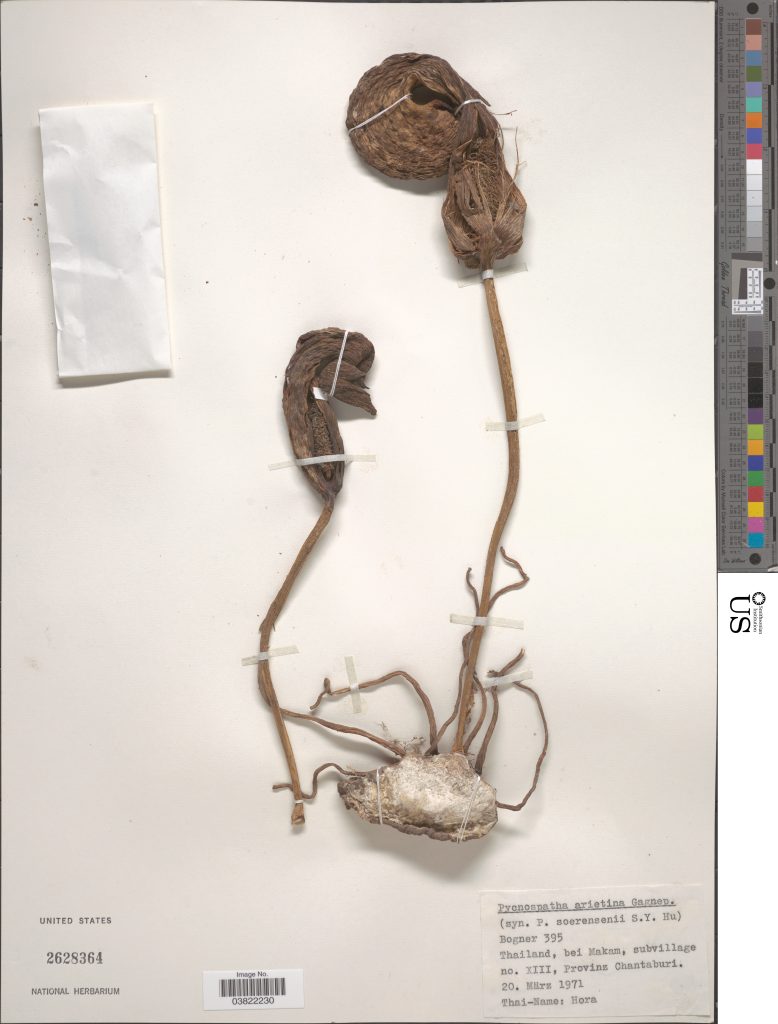
❷Pycnospatha palmata

Amorphophallus
Description
Amorphophallus is a genus belongs to Araceae that known worldwide for the Titan Arum (Amorphophallus titanum), said as the largest flower in the world. The genus Amorphophallus comprises 237 different plant species19. Since its discovery, it has garnered attention from around the world. The peculiar yet captivating appearance has fascinated cultivators worldwide. Most of the species take several years for the flower to bloom, but the joy when it finally does is truly remarkable. Leaf: The sizes are various, from very small to over 2 meters in height. They exhibit a consistent form characterized by a vertical petiole extending from an underground tuber and a horizontally spreading leaf blade, resembling an umbrella. Since the tuber serves as the stem, the above-ground part forms a large single leaf. The petiole often displays patterns, and though various theories suggest reasons, the definitive explanation remains unclear. The shape of the leaf blade ranges from elliptical to linear. The leaf has the diverse appearances, summarizing them all in a single description is hard.

Tuber: Sizes are various, from small, bean-sized specimens to massive ones weighing up to 70 kg (≒154.3 lb). In most cases, tubers tend to grow larger over time. Shapes range from elliptical to elongated and slender.

Roots: Roots emerge from base of the place where the leaf emerge. They are white. Inflorescence: The heights are various, ranging from very small ones at 5 cm to extremely large ones at 5 meters. Despite the differences in size, they consist of a cylindrical flower part called the Spadix and the surrounding bract called the Spathe. The Spadix is composed of three parts: the top part called the Appendix, the middle part with Male flowers, and the bottom part with Female flowers. The shape of the Spathe is diverse and primarily serves the role of attracting pollinating insects. Many species in this family exhibit thermogenesis during flowering, with the Appendix and Male flowers being the main contributors to the heat production. During flowering, many species release various scents, such as mushroom, cheese, carrion, fruits, cow dung, fried fish, carrots, among others, to attract pollinating insects. Some species in this genus have hairy Appendix.
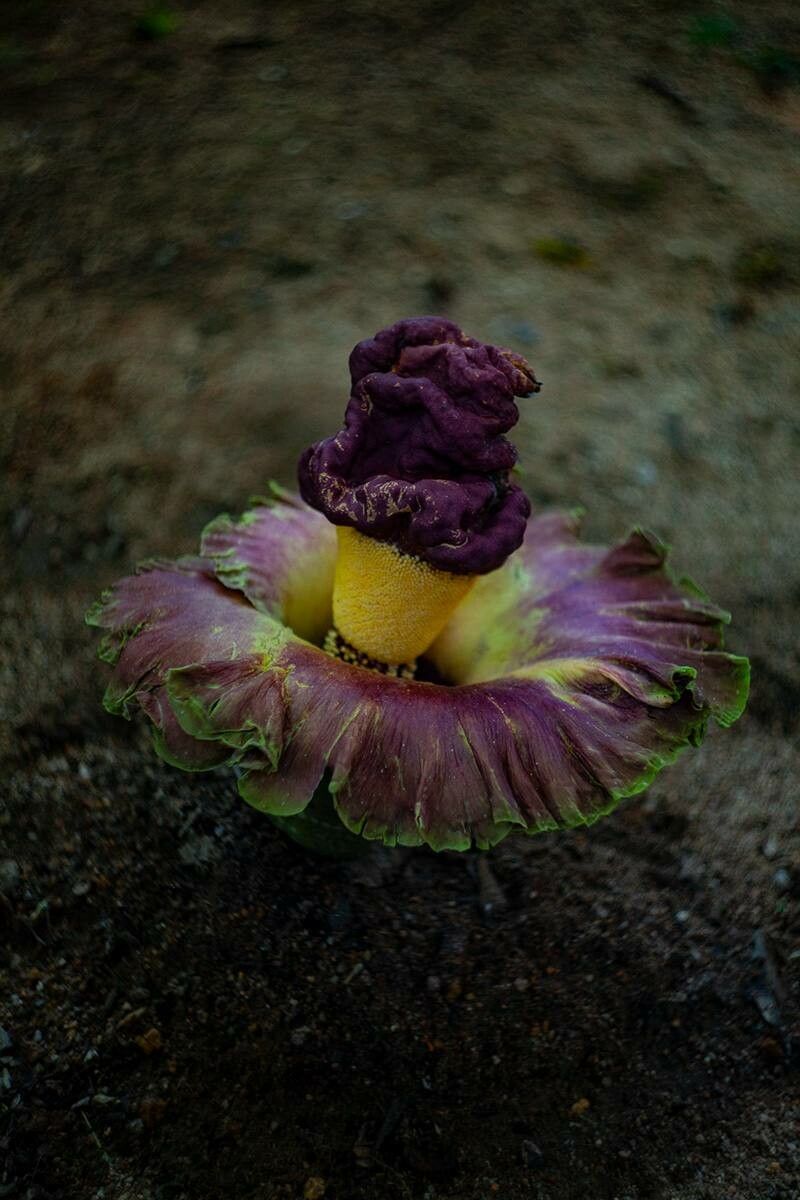
Fruits: The sizes are various, from large to small, but the differences are not very distinct. It contains 1 to 3 seeds. In many species, as the fruit develops, the color changes from orange to red. There are also blue and white seeds. The infructescence is almost cylindrical.
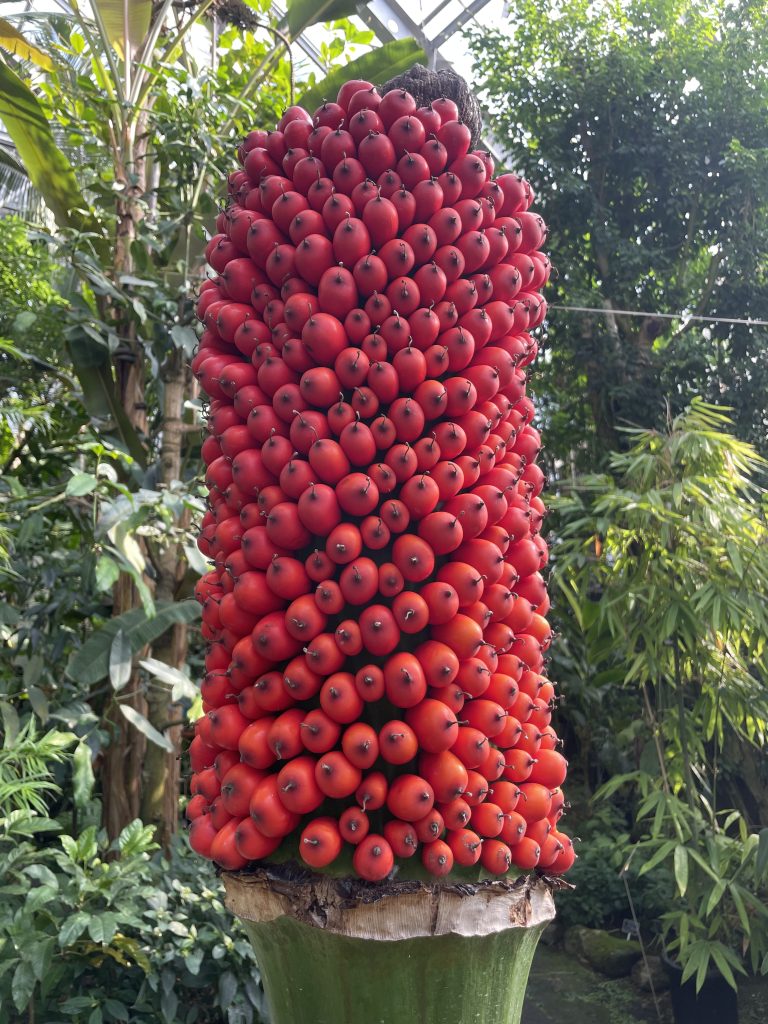

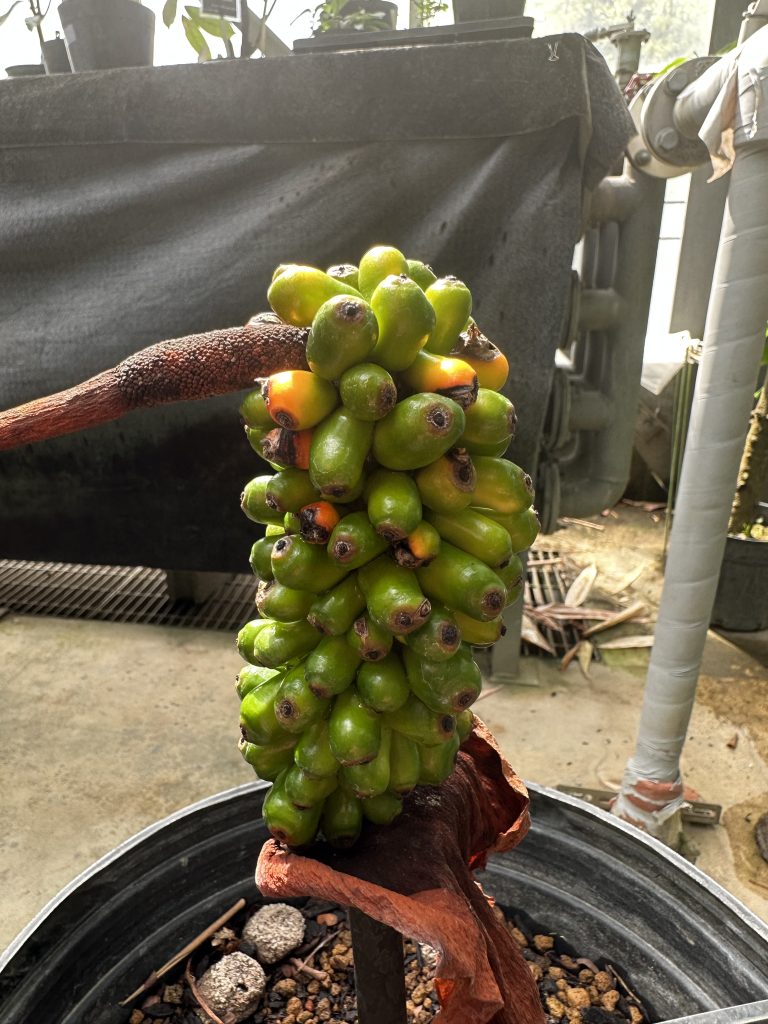
Seeds: It is almost ellipsoid. The seed coat is smooth and thin. The embryo is large, and there is no endosperm.
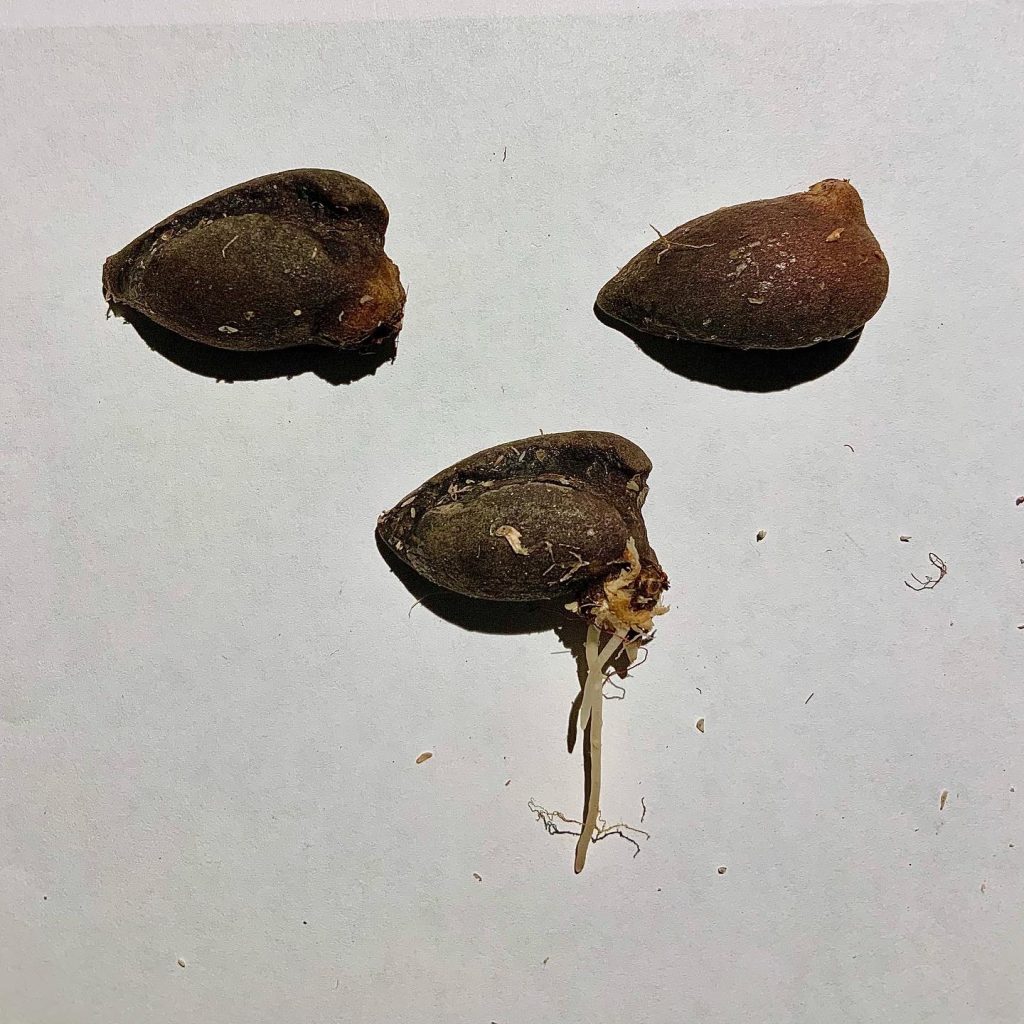
Distribution25
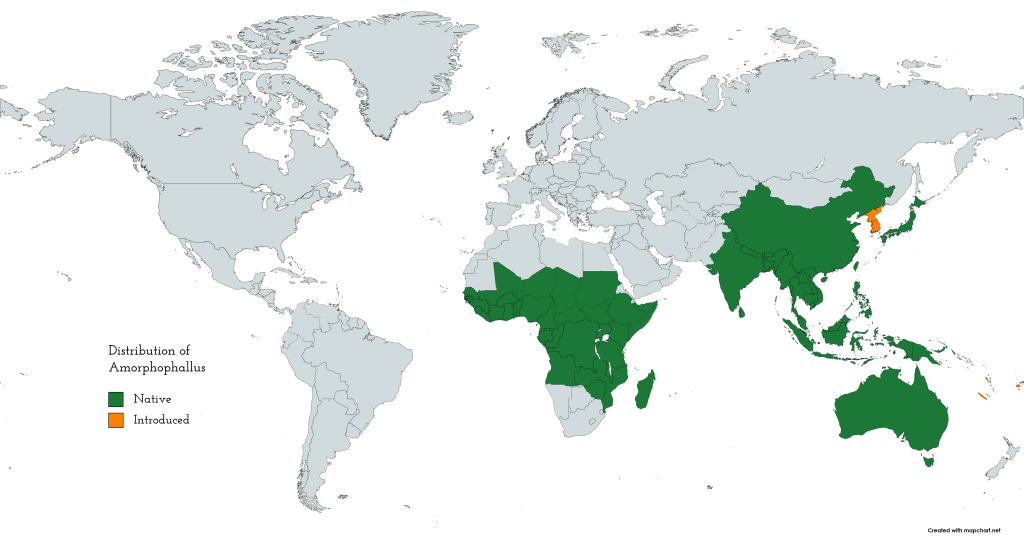
Native to: Andaman Is., Angola, Assam, Bangladesh, Benin, Borneo, Burkina, Burundi, Cabinda, Cambodia, Cameroon, Caprivi Strip, Central African Repu, Chad, China South-Central, China Southeast, Congo, East Himalaya, Ethiopia, Gabon, Gambia, Ghana, Guinea, Guinea-Bissau, Gulf of Guinea Is., Hainan, India, Ivory Coast, Japan, Jawa, Kenya, Laos, Lesser Sunda Is., Liberia, Madagascar, Malawi, Malaya, Mali, Maluku, Mozambique, Myanmar, Nansei-shoto, Nepal, New Guinea, Nicobar Is., Niger, Nigeria, Northern Territory, Philippines, Queensland, Senegal, Sierra Leone, Somalia, Sri Lanka, Sudan, Sulawesi, Sumatera, Taiwan, Tanzania, Thailand, Togo, Uganda, Vietnam, Western Australia, Zambia, Zaïre, Zimbabwe Introduced into: China North-Central, Comoros, Cook Is., Fiji, Korea, Marquesas, New Caledonia, Niue, Samoa, Seychelles, Society Is., Tibet, Trinidad-Tobago, Vanuatun
Ecology26
Tropical humid forest, seasonal forest, open woodlands; geophytes, sometimes in humus deposits on rocks (limestone), also in waste places or areas of human habitation (e.g. A. paeoniifolius).
Etymology27
Greek amorphos (deformed) and phallus (penis), referring to the spadix appendix (especially of Amorphophallus paeoniifolius).
Anaphyllum
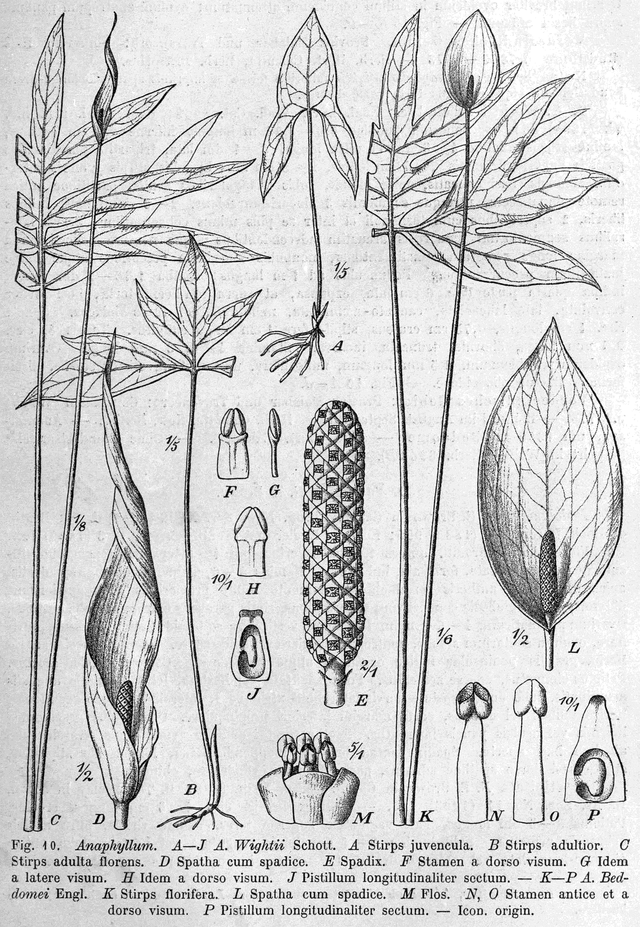
Description28
HABIT: evergreen herbs, clump- or colony-forming, rhizome creeping. LEAVES: solitary to few. PETIOLE: smooth to tuberculate, geniculate apically, sheath short. BLADE: sagittate-hastate to pedatifid when juvenile, trisect at maturity, anterior division remotely pinnatisect with ± oblong-lanceolate, acute lobes, the upper ones decurrent, posterior divisions either ± oblong-lanceolate or deeply divided into 3 coherent segments, rachis geniculate at insertion of anterior and posterior divisions; basal ribs well-developed, primary lateral veins of ultimate lobes pinnate, running into marginal vein, higher order venation reticulate. INFLORESCENCE: solitary. PEDUNCLE: very long and slender, similar in colour and texture to petiole. SPATHE: membranous to coriaceous, marcescent, either convolute basally and becoming spirally twisted and long-acuminate apically, or oblong-ovate, ± flat and fully expanded. SPADIX: cylindric, much shorter than spathe, stipitate or sessile, flowering sequence basipetal. FLOWERS: bisexual, perigoniate, tepals 3–4, fornicate. STAMENS: 3–5, free, filaments fairly wide, connective slender, thecae ellipsoid, dehiscing by short, apical, pore-like slit. POLLEN: monosulcate, ellipsoid, medium-sized (mean 29 µm., range 25–33 µm.), exine foveolate to reticulate, sometimes with elevated psilate regions, apertural exine psilate. GYNOECIUM: ovary ovoid, 1-locular, ovule 1, hemianatropous, funicle short, placenta parietal on single intrusive septum, stylar region thick, attenuate, stigma subcapitate, exuding droplet at anthesis. BERRY: ovoid, smooth, red. SEED: ovoid, funicle slender, testa membranaceous, smooth, embryo stout, straight, endosperm absent.
Distribution
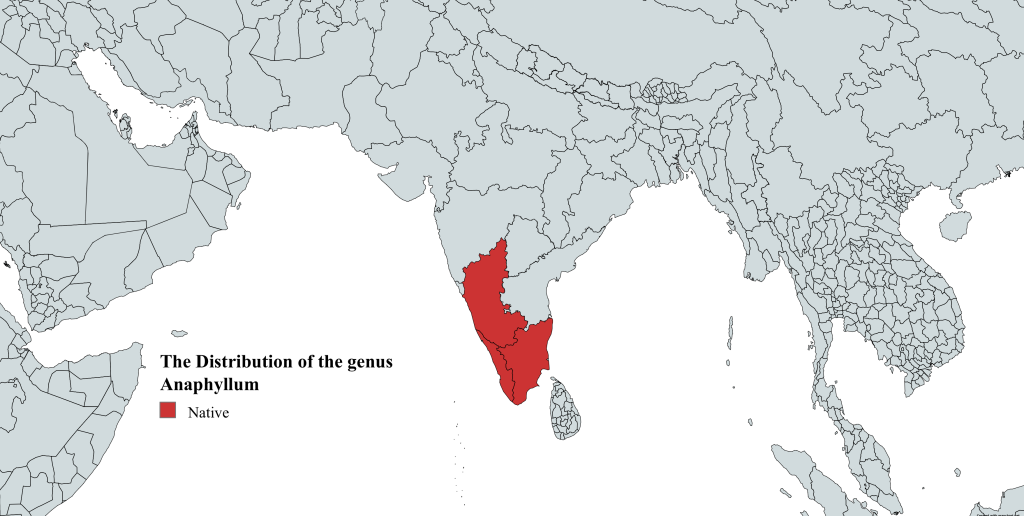
Native to: South West India.
Ecology29
Tropical evergreen forest in leaf litter and in swamp forest undergrowth; geophytes rare.
Etymology
Greek ana- (up, erect) and phyllon (leaf).
Species
Two species belong to this genus. ❶Anaphyllum wightii
❷Anaphyllum beddomei
References
- Croat, Thomas & Boyce, Peter. (2023). Überlist – April 2023. ↩︎
- IAS Aroid Quasi Forum ↩︎
- Mayo, Simon & Bogner, Josef & Boyce, Peter. (1997). The Genera of Araceae. ↩︎
- The Araceae Family ↩︎
- European Aroid Society ↩︎
- Eminium koenenianum – Lobin & Boyce 1991.pdf (aroid.org) ↩︎
- Mayo, Simon & Bogner, Josef & Boyce, Peter. (1997). The Genera of Araceae. ↩︎
- Mayo, Simon & Bogner, Josef & Boyce, Peter. (1997). The Genera of Araceae. ↩︎
- Eminium Schott | Plants of the World Online | Kew Science ↩︎
- Mayo, Simon & Bogner, Josef & Boyce, Peter. (1997). The Genera of Araceae. ↩︎
- Mayo, Simon & Bogner, Josef & Boyce, Peter. (1997). The Genera of Araceae. ↩︎
- Croat, Thomas & Boyce, Peter. (2023). Überlist – April 2023. ↩︎
- Hay, Alistair. (1992). Tribal and Subtribal Delimitation and Circumscription of the Genera of Araceae Tribe Lasieae. Annals of the Missouri Botanical Garden. 79. 184. 10.2307/2399817. ↩︎
- Boyce, Peter & Boyce, & Sookchaloem, Assoc.Prof.Dr.Duangchai & Hetterscheid, Wilbert & Gusman, & Jacobsen, Niels & Idei, & Van Du, Nguyen. (2012). Flora of Thailand – Araceae & Acoraceae. ↩︎
- Mayo, Simon & Bogner, Josef & Boyce, Peter. (1997). The Genera of Araceae. ↩︎
- Van Du, Nguyen & Boyce, Peter. (2011). Pycnospatha (Araceae: Lasioideae), a new generic record for the flora of Cambodia and Vietnam. Gardens’ Bulletin Singapore. 62. 291-295. ↩︎
- Aroideana Vol. 32 p2-p7 ↩︎
- Aroideana Vol. 32 p2-p7 ↩︎
- Croat, Thomas & Boyce, Peter. (2023). Überlist – April 2023. ↩︎
- Wikimedia Commons ↩︎
- flickr ↩︎
- Pl@ntNet ↩︎
- flickr ↩︎
- Wikimedia Commons ↩︎
- Amorphophallus Blume ex Decne. | Plants of the World Online | Kew Science ↩︎
- Mayo, Simon & Bogner, Josef & Boyce, Peter. (1997). The Genera of Araceae. ↩︎
- Mayo, Simon & Bogner, Josef & Boyce, Peter. (1997). The Genera of Araceae. ↩︎
- Mayo, Simon & Bogner, Josef & Boyce, Peter. (1997). The Genera of Araceae. ↩︎
- Mayo, Simon & Bogner, Josef & Boyce, Peter. (1997). The Genera of Araceae. ↩︎

